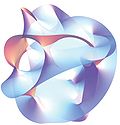Wikipedia:Today's featured article/May 9, 2014
In mathematics and theoretical physics, mirror symmetry is a relationship between geometric objects called Calabi–Yau manifolds (pictured). The term refers to a situation where two Calabi–Yau manifolds look very different geometrically but are nevertheless equivalent when employed as extra dimensions of string theory. Mirror symmetry was originally discovered by physicists. Mathematicians became interested in this relationship around 1990 when Philip Candelas, Xenia de la Ossa, Paul Green, and Linda Parks showed that it could be used as a tool in a branch of mathematics called enumerative geometry. Today mirror symmetry is a major research topic in pure mathematics, and mathematicians are working to develop a mathematical understanding of the relationship based on physicists' intuition. Mirror symmetry is also a fundamental tool for doing calculations in string theory, and it has been used to understand aspects of quantum field theory, the formalism that physicists use to describe elementary particles. Major approaches to mirror symmetry include the homological mirror symmetry program of Maxim Kontsevich and the SYZ conjecture of Andrew Strominger, Shing-Tung Yau, and Eric Zaslow. (Full article...)
Recently featured: Doom Bar – Albert Ball – Castlevania: Aria of Sorrow

